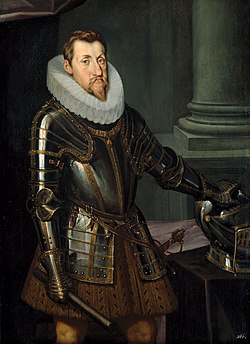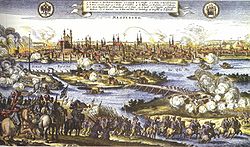
The Thirty Years' War was a conflict that raged across Europe, but primarily Central Europe, between 1618 and 1648. The war was the culmination of the wars of religion which had ravaged European life and society since the inception of the Protestant Reformation in 1517, as Protestants and Catholics fought viciously to promote their respective religious ideologies. In the case of the Thirty Years' War, it initially broke out as the Austrian Habsburgs, who had dominated the office of Holy Roman Emperor across Germany and surrounding lands for centuries, sought to impose a more absolute form of Roman Catholicism both within their territory of Bohemia (approximating to modern-day Czechia) and then across the wider Holy Roman Empire, an amorphous political system which had Lutherans, Calvinists and Catholics in charge of different places. These efforts were initially successful, but every time the Austrian Habsburgs seemed to be becoming too powerful, a foreign power would intervene on behalf of Central Europe’s Protestants, with Denmark being the first nation to do so, followed by Sweden and then France. The war was the bloodiest in early modern European history and claimed anywhere between 4 and 12 million lives. It was marked by atrocities between Catholics and Protestants and consequently led to people fleeing from certain regions for fear of their lives. Hence, the demography of Central Europe was considerably changed on the basis of religious affiliation.[1]
Chronology of eventsChronology of events
The Protestant Reformation, which began in Germany in 1517 following the calls for reform of the church made by Martin Luther, was a period of immense religious and social turmoil across Europe as some countries like Denmark, England and Sweden adopted Protestantism. They were bitterly opposed by the more prominent Roman Catholic powers such as the Papal State, Spain, and the Austrian Habsburgs. The situation was particularly fraught in Germany, a region that was divided into hundreds of small and medium-sized principalities, ecclesiastical states, duchies, and even free cities in early modern times. Here, things were very divided, with some states like Bavaria maintaining a staunch Catholicism, but others such as Saxony becoming Lutheran. What complicated matters even further was the arrival of Calvinism as a form of more advanced Protestantism to Central Europe in the 1540s and 1550s. Owing to this, many states like Brandenburg and the Palatinate became Calvinist. The Austrian Habsburgs had a loose authority over the entire region as Holy Roman Emperors, but even their religious power was fractured with parts of their ancestral lands such as the Kingdom of Bohemia and some parts of the Kingdom of Hungary, both of which Austria ruled at the time, having significant numbers of Protestants.[2]

The war broke out in 1618, owing to a crisis in Bohemia over the desire for the predominantly Protestant nobles of the region to assert their religious rights against the efforts of the government in Vienna to impose more stringent Catholicism. It soon expanded from a revolt of the Bohemian nobles to involve other German powers such as the Palatinate, the Elector of which, Frederick V, intervened on behalf of the Bohemian nobles. This was just the first stage in the war, one in which the newly Austrian ruler from 1619, Ferdinand II, became determined to impose Catholicism across all of Germany and nearly succeeded in doing so through successful military campaigns in the early 1620s.[3]
There then followed a period of twenty years during which various other European powers intervened out of a mix of a desire to protect the rights of Germany’s Protestants, as well as their own self-interest. For instance, Denmark intervened briefly from 1625 to aid their fellow Protestants. Then the Swedes intervened under their king Gustavus Adolphus from 1629, leading to major military reversals for the Austrians.[4] But eventually the Swedish advance southwards towards Vienna stalled and was reversed, finally requiring Catholic France to become involved, in an attempt to prevent the Habsburgs, a royal family which ruled both Austria and Spain, to become too powerful. The war then dragged on until the mid-1640s before peace negotiations were entered into. The Peace of Westphalia of 1648 determined that each state within Germany, not matter how small, should be allowed to determine its own religion and that the Austrian Habsburgs’ powers as Holy Roman Emperors should not be allowed to supersede this autonomy. The Peace of Westphalia has a larger significance in the field of international diplomacy in that it enshrined the principle that states should not interfere in the domestic affairs of each other.[5]
Extent of migrationExtent of migration
There was extensive migration involved in the Thirty Years War, principally as people fled religious persecution in different regions over time. For instance, when the Austrians largely suppressed the revolt in Bohemia in the course of 1619 and 1620 and imposed greater control over the country, many Protestants sought out religious refuge elsewhere. Similar circumstances prevailed in a wide range of areas stretching from the Rhineland in Western Germany to Pomerania in northern Germany and south into Austria, Hungary, and Bohemia at various times during the conflict. The exact extent of this migration is unclear; it was compounded by events after the Peace of Westphalia as tens of thousands of people left states to join their co-religionists in other parts of Central Europe.[6]
Demographic impactDemographic impact

The overall demographic impact of the Thirty Years War is hard to assess. Some of the impact, indeed the greater element of it, was owing to the fighting itself. Historians debate the exact extent of the death and place it anywhere between 4 and 12 million, but between 8 and 10 is the most likely range. Because much of this involved religious pogroms when cities and towns were seized, this tended to lead to a drop in the number of Protestants or Catholics in a particular region as the battle lines became more clearly drawn. And this process continued on beyond 1648 with more Protestants drifting towards communities of Protestants and vice-versa for Catholics. Thus, one of the major impacts of the war was that it tended to make some parts of Central Europe such as Bavaria and Austria more monolithically Roman Catholic, while others like Brandenburg and Prussia became more uniformly Protestant in their composition.[7]
Explore more about Thirty Years WarExplore more about Thirty Years War
- German record collection at MyHeritage
- British record collection at MHeritage
- Danish record collection at MHeritage
- Swedish record collection at MHeritage
References
- ↑ Thirty Years’ War. History Channel
- ↑ https://education.nationalgeographic.org/resource/protestant-reformation/
- ↑ The 1618 Defenestration of Prague explained. History Extra
- ↑ About: Swedish intervention in the Thirty Years' War. DBpedia
- ↑ Mark, Joshua J. Thirty Years' War. World History Encyclopedia
- ↑ Europe’s apocalypse: the Thirty Years' War. History Extra
- ↑ The Peace of Westphalia. Library of Congress

